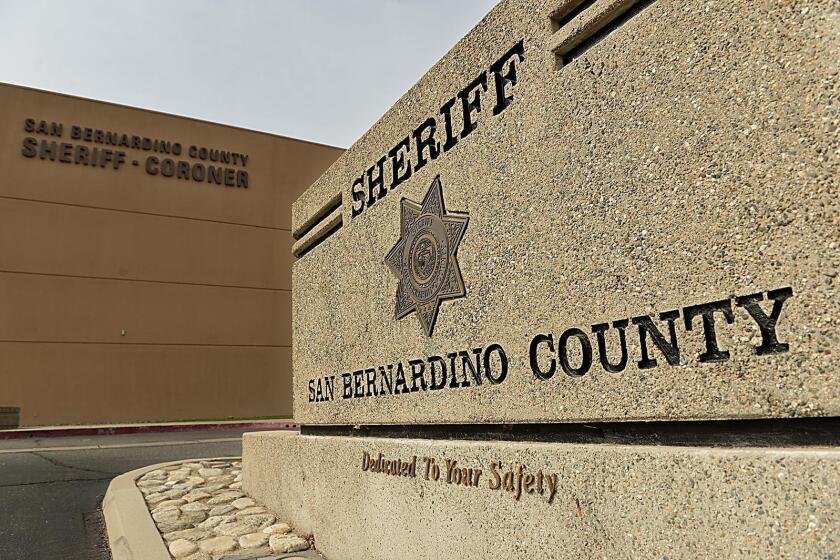Jury delivers guilty verdict against Paul Pelosi’s attacker. Here’s why the case was complicated (but quick)

- Share via
Good morning. It’s Friday, Nov. 17. Here’s what you need to know to start your day.
- A quick verdict is reached against Paul Pelosi’s attacker
- The 10 Freeway could reopen by Tuesday “at the latest”
- 9 commonsense tips that can keep you sane during Thanksgiving travel
- And here’s today’s e-newspaper
Sign up for Essential California
The most important California stories and recommendations in your inbox every morning.
You may occasionally receive promotional content from the Los Angeles Times.
A quick verdict reached against Paul Pelosi’s attacker
It took only four days for a jury to hear the evidence and decide that an East Bay man broke into the home of former U.S. House Speaker Nancy Pelosi last October with the intention of kidnapping her and attacked her husband with a hammer.
David DePape, 43, was found guilty of attempted kidnapping of a U.S. official and assault of a U.S. official’s immediate family member in a San Francisco federal court on Thursday. He faces up to 50 years in prison for those two charges, according to the U.S. Department of Justice.
“The case consumed the nation for more than a year,” Times politics reporter Hannah Wiley wrote this week, “with former President Trump and conservative commentators using the attack to rile up their far-right base and swipe at the Democratic congresswoman, raising broader concerns over political violence and the safety of public officials and their families.”
The assault on Paul Pelosi by DePape was never in question, due to considerable evidence. Police body-camera video showed DePape striking the then-82-year-old Pelosi with a hammer, which caused skull fractures and other injuries. DePape also gave multiple confessions during police interviews.
But the assault case was complicated “because the federal trial focused on his intent, not whether he committed the violent act,” Hannah explained.
The case centered on whether DePape intended to kidnap Speaker Pelosi “on account of or during the performance of her official duties” or attacked her husband “with the intent to retaliate against [Nancy Pelosi] on account of the performance of official duties.”
Prosecutors argued DePape targeted her based on her key role as leader of the Democratic Party in the U.S. House of Representatives, presenting to jurors evidence that DePape had for months prepared what they called his “violent plan” to kidnap the then-speaker. The evidence included his Amazon purchases and other search history. Prosecutors also noted that DePape brought zip ties, rope and duct tape with him the night of the attack, all supporting their argument that he intended to hold Pelosi hostage.
DePape’s defense attorneys attempted to emphasize a separation between Pelosi’s official duties and personal life. While they did not dispute their client’s actions, they argued he was motivated by baseless QAnon-like conspiracy theories rather than a plan to use violence against Pelosi based on her government duties. They added that the lawmaker was not the only person he intended to target in what he perceived as an effort to “root out the corruption of the ruling class, … stop the molestation of children and expose the truth to everyone.”
But that didn’t convince the jurors, who returned their guilty verdict 24 hours after closing arguments.
“This guilty verdict on all counts sends a clear message that regardless of what your beliefs are, what you cannot do is physically attack a member of Congress or their immediate family for their performance of their job,” Ismail Ramsey, U.S. attorney for the Northern District of California, said at a news conference after the trial.
DePape also faces state charges of attempted murder, assault with a deadly weapon, elder abuse, burglary and threats to a public official and their family. A hearing to set his trial date for those charges is slated for Nov. 29.
Today’s top stories

I-10 closure
- Gov. Gavin Newsom announced Thursday that the fire-damaged 10 Freeway will be reopened sooner than expected — Tuesday “at the latest.”
- The state was long aware of conditions under Interstate 10 where a massive fire Saturday severely damaged the freeway south of downtown Los Angeles.
Housing
- A Times investigation has found that many of the AIDS Healthcare Foundation’s more than 1,300 tenants live in squalid conditions, with dozens under the threat of eviction.
- Southern California home prices are nearing a record high at a time of sky-high mortgage rates.
Politics
- California’s population of unauthorized immigrants has dropped.
- In 2020 and 2022, Trump and Florida Gov. Ron DeSantis picked up support among Latinos in Florida. Could that be a harbinger for Arizona and Nevada — and maybe even swaths of California?
- Rural Latino voters feel ignored by Senate candidates.
- About 250 pro-Palestinian protesters blocked off traffic on the San Francisco-Oakland Bay Bridge for hours on Thursday, which came as President Biden and world leaders met in the area for the Asia-Pacific Economic Cooperation conference.
- Here’s why polls can’t tell you if Biden beats Trump again in 2024 — or vice versa.
Crime and courts
- A ‘catfishing’ cop killed three family members. A relative is suing the sheriff’s office that gave him a badge.
- An L.A. sheriff’s deputy shot a man in the back. Two years later, the case remains open.
- An L.A. County sheriff’s deputies union recently elected to its board a veteran lawman with a controversial tattoo who was involved in two shootings that cost the county $4 million.
- Eric Kay’s appeal was denied in a fentanyl case that killed Angels pitcher Tyler Skaggs.
More big stories
- Rain returns to Southern California on Friday after a brief break.
- Billie Eilish obtains a restraining order after she says a stalker sent threats and visited her home.
- Sean ‘Diddy’ Combs has been accused of rape and a ‘cycle of abuse’ by his ex Cassie in a new lawsuit.
Get unlimited access to the Los Angeles Times. Subscribe here.
Commentary and opinions
- Sammy Roth: California strikes another blow against rooftop solar.
- Michael Hiltzik: AI investors say they’ll go broke if they have to pay for copyrighted works. Don’t believe it.
- Opinion: I’m the child of a Holocaust survivor. I know the trauma inflicted on Gaza will last for generations.
- Opinion: Biden’s executive order on AI is ambitious — and incomplete.
Today’s great reads
Are your sneakers knockoffs? He can tell by the smell. At CoolKicks on Melrose Avenue, shoe buyer and lead authenticator Rami Almordaah flips, pokes and even smells sneakers to determine whether they’re the real deal. (Pro tip: glue smell means it’s fake.)
Other great reads
- The Curse of Cade? How one play may have led to 25 years of misery for UCLA football.
- A ‘Black to the land’ farm leans into African American heritage to fight climate change.
- Want to know if your gas bill will increase this winter? SoCalGas can warn you with a text.
How can we make this newsletter more useful? Send comments to essentialcalifornia@latimes.com.
For your downtime
Going out
- 🌲🏠 Disneyland just revitalized one of its most underrated attractions.
- 🤳🏽Instead of focusing on Hollywood’s boldface names, the new TMZ Selfie Tour gives someone else the star treatment: You.
- 🚢 A Taylor Swift-themed cruise sets sail in 2024. Just don’t expect the singer to be there.
- 🛫 9 commonsense tips that can keep you sane during Thanksgiving travel.
Staying in
- 👟Can you guess what these collectible sneakers cost? Test your knowledge of the hot collectible sneaker market.
- 📕 California Poet Laureate Lee Herrick, who celebrates the state in his book “My California,” joins the virtual L.A. Times Book Club on Dec. 12.
- 👽 The scariest thing about UFOs? In his new book, Garrett Graff says it’s not the aliens.
- 🐇 📺 Apple TV+’s ‘The Velveteen Rabbit’ aims to retain the ‘emotional heart’ of a beloved tale.
- 🧑🍳 Here’s a recipe for suá green beans with shiitake “bacon.”
- ✏️ Get our free daily crossword puzzle, sudoku, word search and arcade games.
And finally ... a great photo
Show us your favorite place in California! Send us photos you have taken of spots in California that are special — natural or human-made — and tell us why they’re important to you.

Today’s great photo is from Bob Keats of Santa Barbara: Gaviota Coast. Bob writes:
The Gaviota Coast contains the last significant stretch of relatively undeveloped and unprotected rural coastal land in Southern California, and it includes the sites of two Indigenous American villages, Kuya’mu and Mikiw. For many years, environmental organizations, including the Kuya’mu Park Assn., the Surfrider Foundation, the Gaviota Coast Conservancy and the Environmental Defense Center, have been trying to conserve the cultural landscape of Kuya’mu and Mikiw, as well as the ecological resources of the surrounding coastal terrace, for the benefit of future generations.
Have a great day, from the Essential California team
Ryan Fonseca, reporter
Elvia Limón, multiplatform editor
Kevinisha Walker, multiplatform editor
Laura Blasey, assistant editor
Check our top stories, topics and the latest articles on latimes.com.
Sign up for Essential California
The most important California stories and recommendations in your inbox every morning.
You may occasionally receive promotional content from the Los Angeles Times.






